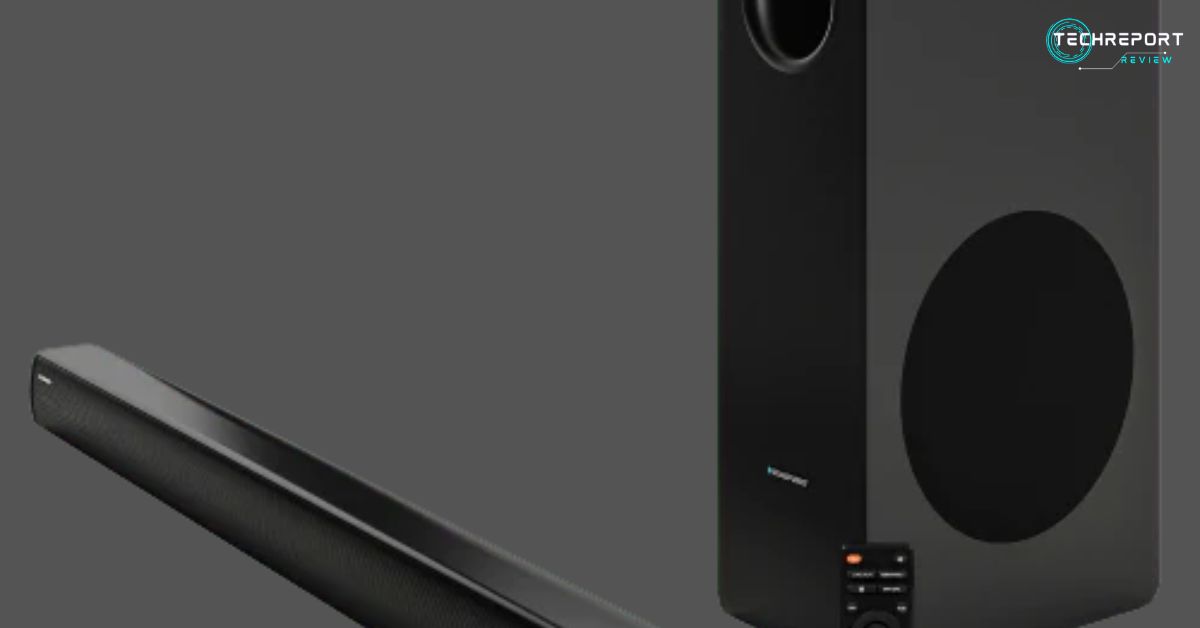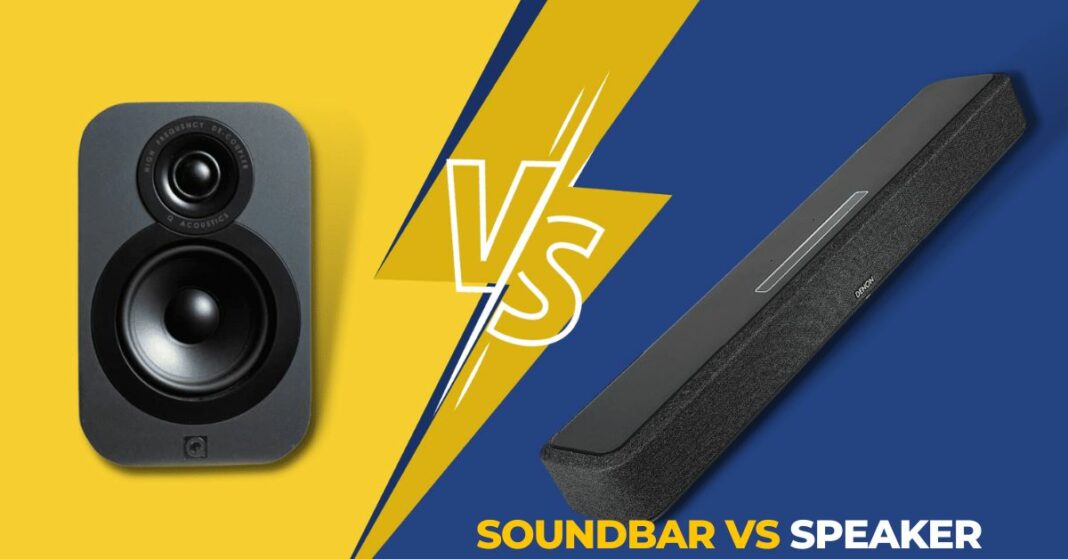Soundbars and speakers are two of the most popular options when it comes to improving the audio quality of your home entertainment system. A soundbar is a long, narrow speaker that is designed to sit under your TV, while a speaker system typically consists of two or more separate speakers that can be placed around the room.
The purpose of this blog post is to compare and contrast soundbars and speakers, and to help you decide which one is the best choice for your home entertainment system. We will discuss the advantages and disadvantages of each option, as well as how to set them up and what to look for when purchasing one.
The first speakers were invented in the late 1800s and were used primarily for telephones and phonographs. As technology improved, speakers became a key component of home entertainment systems, providing immersive audio for movies, music, and gaming. Soundbars, on the other hand, are a relatively new invention, with the first models appearing in the early 2000s. They were designed to provide a more streamlined and convenient option for improving TV audio. Since then, both soundbars and speakers have continued to evolve and improve, with new technologies and features being added all the time.
Soundbar Overview
A soundbar is a slim, elongated speaker that is designed to be placed below or above your TV screen. They come in various shapes and sizes and are a great option for those who want to enhance their TV’s sound quality without investing in a complete home theater system.
Features of Soundbars
Soundbars come with a range of features, such as built-in amplifiers, wireless connectivity options, and multi-room audio capabilities. Some of the latest soundbars also come with voice assistants like Amazon Alexa or Google Assistant, which can be used to control your soundbar and other smart home devices.
Sound Quality of Soundbars
The sound quality of soundbars has improved significantly over the years. Many of the latest models come with advanced sound technologies like Dolby Atmos and DTS:X, which create a more immersive and realistic audio experience. Soundbars are also capable of producing a decent amount of bass, but some models come with a separate subwoofer for even better bass response.
Wireless Capabilities of Soundbars
Most modern soundbars come with wireless connectivity options like Bluetooth and Wi-Fi, which allow you to stream music from your smartphone, tablet, or laptop. Some models also come with built-in Chromecast, AirPlay, or Spotify Connect, which make it easy to access your favorite music streaming services.
Setup Process for Soundbars
Setting up a soundbar is usually a quick and easy process. Most models come with an HDMI cable that you can use to connect the soundbar to your TV. Some models also come with an optical cable, which can be used as an alternative to HDMI. Once the soundbar is connected to your TV, you can use the included remote control to adjust the volume and settings.
Available Sound Modes for Soundbars
Many soundbars come with different sound modes that are designed to optimize the audio for different types of content. For example, some soundbars come with a movie mode, which enhances the dialogue and sound effects in movies, while others have a music mode, which optimizes the audio for music playback.
Surround Sound Options for Soundbars
Some soundbars also come with surround sound capabilities, which create a more immersive audio experience. These soundbars use advanced audio processing techniques to simulate surround sound without the need for additional speakers.
Advantages and Disadvantages of Using a Soundbar

| Advantages | Disadvantages |
| Compact and easy to install | Limited bass response |
| Enhances TV sound quality | Some models require a separate subwoofer for optimal sound quality |
| Wireless connectivity options | May not be as immersive as a complete home theater system |
| Available in a range of prices | |
| Many models come with advanced sound technologies |
Speaker Overview
Speakers are devices that convert electrical signals into sound waves. They are designed to produce sound in a range of frequencies and are available in various sizes, shapes, and types. Speakers are the primary components of any sound system and are responsible for reproducing sound from different sources like televisions, music players, and computers.
Features of speakers
Speakers come in different shapes and sizes, but they generally have similar features. The most important features to consider when buying speakers include sound quality, frequency response, impedance, sensitivity, and power handling. Speakers can also be categorized by their construction and design, such as bookshelf, floor-standing, or in-wall speakers.
Sound quality of speakers
The sound quality of speakers depends on a variety of factors, including their design, construction, and the quality of the materials used to make them. The sound quality of speakers is usually measured by their frequency response, which refers to the range of frequencies that they can accurately reproduce. The higher the frequency response, the more accurately the speakers can reproduce high-frequency sounds like cymbals and vocals.
Wired and wireless capabilities of speakers
Speakers can be wired or wireless, depending on their design and intended use. Wired speakers connect to an amplifier or receiver using a speaker wire, while wireless speakers use a wireless connection like Bluetooth or Wi-Fi to connect to a music player or sound system. Wireless speakers are becoming increasingly popular due to their convenience and ease of use.
Setup process for speakers
Setting up speakers can be a complex process, depending on the type and number of speakers involved. The basic setup involves connecting the speakers to an amplifier or receiver and positioning them correctly for optimal sound quality. In some cases, additional equipment like subwoofers or soundbars may be required to achieve the desired sound quality.
Available sound modes for speakers
Speakers can come with a variety of sound modes, including stereo, surround, and mono. Stereo speakers use two speakers to reproduce sound in two channels, while surround speakers use multiple speakers to create a more immersive sound experience. Mono speakers use a single speaker to reproduce sound in one channel.
Surround sound options for speakers
Surround sound options for speakers include 5.1, 7.1, and Dolby Atmos. 5.1 surround sound uses five speakers and a subwoofer to create a surround sound experience, while 7.1 surround sound uses seven speakers and a subwoofer. Dolby Atmos is a newer surround sound technology that uses additional speakers to create a more immersive sound experience.
Advantages and Disadvantages of Using a Speaker
| Advantages | Disadvantages |
| Better sound quality | Higher cost |
| More flexibility in terms of setup and configuration | More complex setup process |
| Wider range of available sound modes | Need for additional equipment like an amplifier or receiver |
Differences between Soundbars and Speakers
When it comes to choosing between soundbars and speakers, it’s important to understand the key differences between the two. In this section, we’ll compare soundbars and speakers in terms of sound quality, wireless capabilities, setup process, available sound modes, surround sound options, and advantages and disadvantages.
Sound Quality Comparison
One of the most significant differences between soundbars and speakers is the sound quality. Speakers usually offer better sound quality than soundbars due to their larger size and more powerful drivers. They can produce deeper bass, clearer midrange, and crisper highs. In contrast, soundbars are more compact and have smaller drivers, which means that they may not be able to produce the same level of sound quality as speakers.
Wireless Capabilities Comparison
Soundbars and speakers both come in wired and wireless options. However, soundbars are more likely to have wireless capabilities than speakers. Many soundbars feature Bluetooth connectivity, which allows you to stream audio from your smartphone or tablet without the need for cables. Some soundbars also come with Wi-Fi connectivity, which allows you to connect to your home network and stream music from your computer or NAS drive. Speakers usually require wires to connect to your audio source, and although some speakers do come with wireless capabilities, they tend to be more expensive.
Setup Process Comparison
Soundbars are usually easier to set up than speakers. With a soundbar, you can simply plug it in, connect it to your TV or audio source, and you’re good to go. In contrast, speakers require more setup time and effort. You need to connect each speaker to an amplifier or receiver and run wires between the speakers and the audio source. This can be a complicated process, particularly if you’re not familiar with audio equipment.
Available Sound Modes Comparison
Both soundbars and speakers can offer a range of sound modes, such as stereo, surround sound, and 3D audio. However, soundbars are more likely to come with built-in sound modes than speakers. This is because soundbars are designed to be an all-in-one solution for your audio needs, whereas speakers require an amplifier or receiver to produce different sound modes.
Surround Sound Options Comparison
Surround sound is an essential feature for a home theater system, and both soundbars and speakers can offer this functionality. Soundbars often come with built-in surround sound processing, which can simulate a surround sound experience using just the soundbar. However, for a truly immersive surround sound experience, you’ll need a set of speakers placed around the room. In contrast, speakers can provide a more authentic surround sound experience since they can be positioned in various places around the room.
Which one is better, Soundbar or Speaker?
When choosing between a soundbar and a speaker, there are several factors that you should consider:
- Sound Quality: Soundbars are designed to be compact and portable, which means that they often have lower sound quality compared to speakers. However, some high-end soundbars can match the sound quality of speakers.
- Room Size: Speakers are better suited for larger rooms where they can produce a more immersive and powerful sound. Soundbars, on the other hand, are better suited for smaller rooms or spaces where a large speaker system may not fit.
- Surround Sound: If you want to experience surround sound, then speakers are the better option. While some soundbars do have surround sound capabilities, they can’t match the immersive experience that speakers provide.
- Price: Soundbars are generally less expensive than speakers, but this can vary depending on the brand and features.
- Home Theater: If you want to create a home theater experience, then speakers are the better option. They offer a more immersive sound experience and can be configured to provide surround sound. You can also add a subwoofer and an amplifier to further enhance the sound quality.
- Small Rooms: If you have a small room or apartment, then a soundbar would be the better option. They are compact and can easily fit into small spaces, and can provide decent sound quality.
- Music: If you are a music lover and want to listen to music with high-quality sound, then speakers are the better option. They provide better sound quality, especially for music with a lot of bass.
- Budget: If you are on a tight budget, then a soundbar would be the better option. They are generally less expensive than speakers and offer good sound quality for the price.
Ultimately, the choice between a soundbar and a speaker will come down to personal preferences. Some people prefer the convenience and portability of a soundbar, while others prefer the immersive sound experience of a speaker system. It’s important to consider your specific needs and preferences when making a decision.
In Crux
In conclusion, choosing between a soundbar and a speaker ultimately depends on personal preference and the intended use case. Soundbars are a great option for those who want a simple and easy-to-set-up audio solution, while speakers are ideal for those who want the best possible sound quality and a customizable setup. Both soundbars and speakers have their advantages and disadvantages, and it is important to weigh these factors against your specific needs and budget.
For those who want a simple and affordable audio solution, a soundbar may be the better option. Soundbars are easy to set up, take up less space, and can provide good sound quality for movies and TV shows. However, if you are looking for the best possible sound quality and a customizable setup, a speaker system is the way to go. Speakers can provide superior sound quality, especially for music and immersive home theater experiences, but they also require more space and a more involved setup process.
The future of audio technology and home theater systems is promising, with advancements in soundbars and speakers continuing to provide better and more immersive audio experiences. With the rise of virtual and augmented reality, we can expect to see even more innovation in the audio space, with technologies like 3D audio and object-based audio becoming more commonplace. As always, it is important to stay informed about the latest advancements and to choose audio solutions that fit your specific needs and preferences.
[WPSM_AC id=1127]
How much did you like our detailed Audio Showdown: Soundbar vs Speaker Review? Also, please share these blogs with your friends on social media.
Related Blogs

























